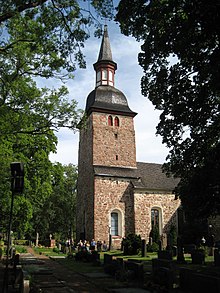Jomala Church
The Church of Jomala is a medieval stone church in the town of Jomala in the autonomous Finnish province of Åland . It is dedicated to Saint Olav and was built between 1275 and 1285. This makes it probably the oldest surviving church and also the oldest stone building in Finland. The church got its present form when it was enlarged and rebuilt in the 19th century.
history
Coin finds made in 1961 during archaeological excavations in the church of Jomala suggest that a wooden predecessor building was built on the same site as early as the early 13th century. On the basis of dendrochronological studies and architectural historical criteria, the nave , church tower and choir of the stone church can be dated to the period between 1275 and 1285. A sacristy and an armory were probably added in the 15th century. The church tower was raised in the 16th or 17th century. It got its current shape in 1749 after the old spire was destroyed by a storm.
In the 19th century, Jomala Church was significantly rebuilt. Between 1820 and 1840 the church was given a north and south cross arm, the medieval choir, the east wall of the nave, as well as the sacristy and armory were demolished. In 1843 the walls and roof of the nave were lowered, and in 1884 the medieval vaults were torn down. The renovation was completed in 1899 with the addition of a new sacristy.
architecture
Jomala Church is made of native red Rapakiwi granite. In its current form it has an unusual T-shaped floor plan, consisting of a short and wide nave and a wide transverse arm in the east. The nave is adjoined by the 52 meter high west tower, the ground floor of which is connected to the interior of the church by an ogival opening. At the east end of the nave there is a sacristy with a separate entrance. The church tower and the nave are medieval in their structure and clearly stand out from the elements built in the 19th century. As the only church in Finland, the church of Jomala can clearly be attributed to the Romanesque style. The original medieval floor plan of the church was also unusual, as the proportions of the nave and tower stand out from the rest of the Åland and Finnish churches.
interior
Shortly after the construction was completed, the medieval parts of the church were decorated with early Gothic Secco paintings of high artistic value. The paintings were probably whitewashed in the 17th century but exposed again in the 1930s. The best preserved is a series of pictures on the wall between the tower and the nave, which depict the story of the prodigal son in four pictures . During archaeological excavations in the church, numerous fragments of medieval glass paintings were found. It is the oldest known stained glass in Finland. The medieval architectural decoration of the church includes a limestone sculpture from the late 13th century, preserved in situ on the wall between the tower and the nave , which depicts the face of a person. The limestone sculpture of an animal's head is now kept in the Åland Museum .
The church inventory includes some valuable medieval wooden sculptures. The oldest is a crucifix from the early 14th century. Somewhat more recent are a Westphalian portrait of Mary from the period between 1320 and 1350 and a sculpture of Saint Anne , which was created in Lübeck around 1400 . In the tower there is a from Gotland derived baptismal font from the 13th century.
literature
- Markus Hiekkanen: Suomen keskiajan kivikirkot (= Suomalaisen Kirjallisuuden Seuran toimituksia 1117). Suomalaisen Kirjallisuuden Seura, Helsinki 2007, ISBN 978-951-746-861-9 , pp. 386-391.
Web links
- Ålands kyrkorna project: Jomala (swedish)
See also
Coordinates: 60 ° 9 ′ 18 ″ N , 19 ° 56 ′ 54 ″ E

